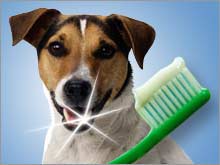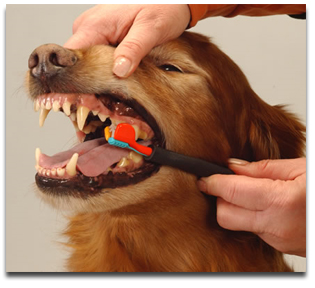

Your dog relies on you for dental care. Dry food and chew toys help but they do not entirely remove tartar at the gum line where dental problems begin. Using a soft, pediatric toothbrush or finger brush and toothpaste designed for dogs and cats will help prevent dental disease. Most dogs, and ferrets accept the taste of these toothpastes readily. It is important to start the tooth brushing routine between 3-6 months of age. Most dogs dislike human toothpaste so do not use it.
Start by simply massaging your pets lips and mouth with your fingers – then give him a treat. When he is used to this, get him accustomed to having his lips and teeth rubbed. Then place a little of the toothpaste on your fingers as you do this. Most of the tartar (80%) forms on the outer (bucal) surface of the teeth so you do not need to spend large amounts of time cleaning the inner surfaces. Concentrate on the rear teeth and the base of the canine teeth (fangs). Begin brushing for very short periods; very gently and very slowly. When you are done, give your pet a treat for being a good patient. Proceed longer and more thoroughly gradually from day to day and stop when your pet begins to squirm or show resentment.
Within a few weeks you should be able to do a rather thorough job. A good time to brush your dog’s teeth in first thing in the morning. Some dogs by nature resent tooth brushing more than others. Difficult dogs will have to rely more on hospital cleaning and specialty diets and treats.